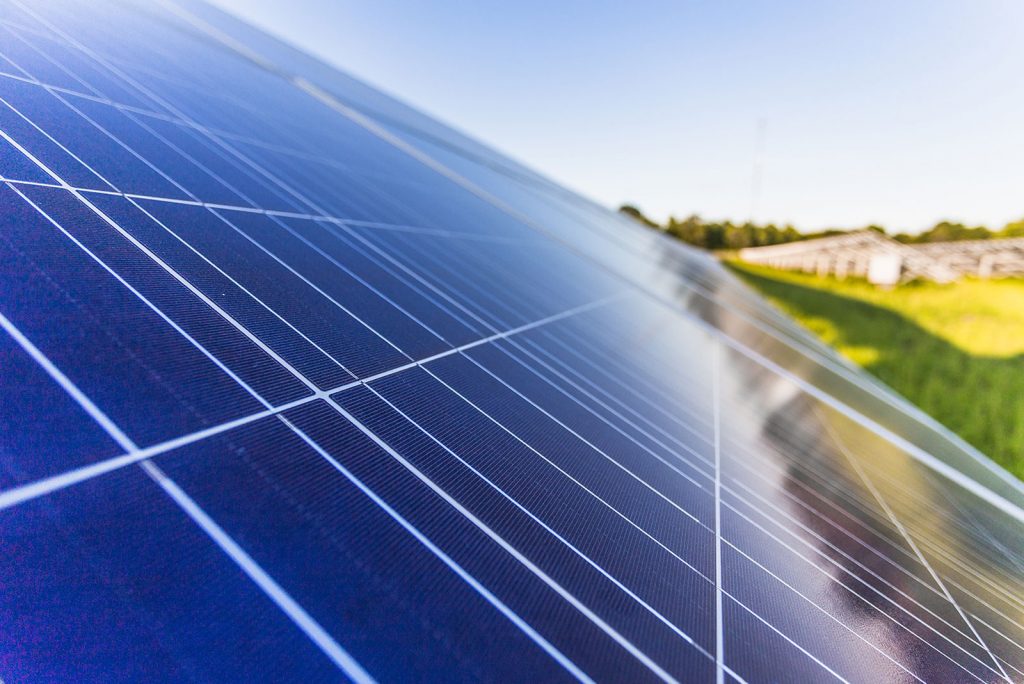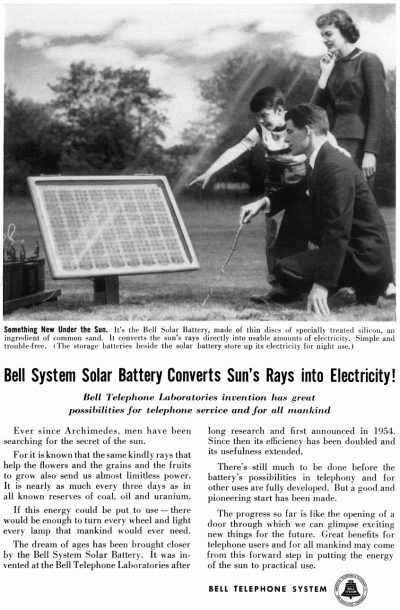
A Brief History of How We Harness the Sun
Every day, our sun provides a significant amount of energy. Enough energy from the sun hits the Earth every hour to power our planet for an entire year! Since the 1800s, scientists have wondered how we can harness this massive energy supply.
Today, the solar industry has become a leading source of renewable power generation as well as the #1 source of employment for the United States’ Electric Power Generation sector’s workforce. The roots of using solar energy for electricity start with discovery and have evolved through innovation. As new products, ideas, and methods are formed, these breakthroughs translate into greater cost efficiency, consumer benefits, and conveniences.
Let’s have a closer look at the history of solar power to better understand this evolution.
The invention of the solar photovoltaic effect
The photovoltaic effect, at its most basic, is the reaction of voltage and electric current inside a solar cell exposed to sunlight. This solar cell process generates the movement of electrons to solar panels, which convert sunlight to electricity.

In 1839, 19-year-old French scientist Edmond Becquerel discovered the photovoltaic effect. He was fascinated with phosphorescence (the emission of light without heat). During his investigation of photochemical reactions, he began to understand the absorption of energy in the form of light, which led to his discovery of the photovoltaic effect. In the late 1860s, he published his findings, noting that “the voltage of the cell increased when its silver plates were exposed to the sunlight.”
In 1873, Willoughby Smith, an engineer from England, discovered the photoconductivity, or the capability to conduct electricity based on the light intensity, of selenium while testing underwater telegraph cables. A decade later, Charles Fritts, an American inventor, made the first solar cells from selenium. He put a thin, wide layer of selenium onto a metal plate and covered it with a semitransparent gold-leaf film to create the first photoelectric module. Fritts generated a current and noted that it was a continuous current despite the intensity of light. At the time, Fritts predicted that the photoelectric plate may one day compete with coal-fired electrical generation.
Development of Solar Panels
The solar cell era begins

By 1953, scientists at Bell Laboratories were revisiting photovoltaic technology, this time using silicon to produce solar cells, further giving enough promise to the technology to support a focused research program. Scientists questioned how the weather impacted the solar cells and wanted to find a way to increase the amount of electricity produced. On April 25, 1954, Bell scientists presented a solar panel of cells that relied exclusively on light power, which they used to run a 21-inch Ferris wheel as a proof of concept. The New York Times wrote, “the silicon solar cell may mark the beginning of a new era, leading eventually to the realization of one of mankind’s most cherished dreams–the harnessing of the almost limitless energy of the sun for the uses of civilization.”
In the late 1950s, early efforts to help widely commercialize solar panels were unsuccessful. While the US Army and Air Force were interested in harnessing solar power as a primary source for a top-secret satellite project, the Navy was ultimately awarded the satellite project and chose to use chemical battery power instead of solar power as an energy source.
In the late 1950s, Dr. Hans Ziegler, a scientist and expert in satellite technology strongly encouraged the Navy to utilize solar cells that would last much longer than chemical batteries. Through much debate, the Navy finally heeded Dr. Ziegler and as a compromise, allowing the placement of a dual power system consisting of chemical batteries and silicon solar cells on the project. Just as Ziegler had suspected, the chemical batteries failed to work after a week and the silicon solar cells continued working for years.
Unfortunately, during the 1960s and 1970s, solar panel technology was often too expensive for mainstream consumer distribution. Nonetheless, as solar cell technology evolved, the cost continued to decline. Dr. Elliot Berman is credited for contributing greatly to the affordability of solar panels in the mainstream market. He was able to help make solar panels more cost-effective by using a lesser grade of silicon and packaging the cells with more cost-effective materials. This shift in solar panel production helped reduce the price of panels, enabling solar panel technology to compete in the wholesale power market for the first time.
America takes notice
In the 1970s President Ronald Reagan commended a pioneer from the Coast Guard, Lieutenant Commander Lloyd Lomer, due to his unwavering dedication to encouraging the transition of powering offshore buoys and other navigational aids from non-rechargeable batteries to solar cell technology. President Reagan honored Lomer for “saving a substantial amount of the taxpayer’s money through your initiative and managerial effectiveness as project manager for the conversion of aids to navigation from the battery to solar photovoltaic power.” Following Reagan, in 1978, President Jimmy Carter signed the Solar Photovoltaic Energy Research, Development, and Demonstration Act that authorized more research, development, and demonstration of solar panel technology in America.
This set the stage for the future of solar panel technology and helped to establish America as a leader in the global market for solar energy. In recent years, there has been an increased focus on renewable energy sources such as wind and solar power. This has led to a surge in research and investment into new technologies that will help make solar panels even more efficient and cost-effective. Solar panel technology continues to evolve, and as we move forward, solar energy will become even more accessible and viable as a renewable energy source. As the world continues to search for ways to reduce our reliance on fossil fuels, solar power is becoming an increasingly attractive option that can help us protect the environment while providing a safe and renewable energy source. It is clear that solar panel technology has come a long way since its humble beginnings, and it looks to be an important part of our future.
How Have Solar Panels Changed Over Time
Solar panel technology today
Since its inception, solar power technology has constantly progressed. Advancements in photovoltaics (PV) and concentrated solar power (CSP) have produced a more effective hybrid technology for solar panel engineering, and have helped lower the cost significantly.

In 2016, MIT researchers produced ultra-slim, flexible solar cells that are only 1.3 microns thick. These lightweight cells weigh the same as soap bubbles, allowing future opportunities for use in certain technologies like cell phones. According to MIT, “conventional silicon-based solar modules produce about 6.8 watts per pound, but these new devices can generate more than 2,720 watts per pound, https://energy.gov/eere/videos/energy-101-solar-pv 400 times as much.” While this advancement is still in the early phases, it could help widen the use of solar technology.
Continued scientific advancements have made vast improvements in solar panel technology, including increasing the capacity to harness more solar energy per unit of surface area. This is a vital factor in panel technology because the more energy a solar panel can absorb, the more efficient the panel becomes at harnessing solar energy. Today, solar panels can deliver at up to 22% efficiency. There have also been ongoing efforts to make solar energy even more affordable and efficient with an emerging technology called the “perovskite” solar cell. This crystalline material could ultimately replace silicon in solar panels and reduce costs using simpler production methods.
The future of solar panels looks promising, with technological advancements and cost-reduction efforts continuing to drive availability. Solar panel technology is now being used in small-scale applications like powering homes and businesses, as well as large-scale ones such as generating electricity for entire cities. Today, solar energy is a viable option for individuals looking to reduce their carbon footprint and save money on energy costs. With continued research and development, solar panel technology is likely to become even more cost-effective in the near future. This will make it an increasingly attractive option for many looking to reduce their environmental impact and power their lives with clean energy.
Explore Solar Power Through Community Solar
Today, most of the electricity generated in the U.S. comes from fossil fuels, like natural gas, coal, and petroleum. Renewable power accounts for just fewer than 15% of U.S. electricity generation, with solar accounting for .9%. As technologies evolve and are optimized, and solar power becomes more accessible and convenient through programs like community solar, there is hope that our production will shift and the solar energy share will grow. The infinite power of the sun is there, waiting for us to harness it.
At Clearway Community Solar, we’re creating pathways for individuals, businesses, and communities to directly access solar power. Our mission is to make solar more accessible by allowing people to reap the benefits of clean energy without having to install panels on their roofs or own any equipment. By joining a community solar farm in your area, you can start saving money on your electricity bills while also doing your part to reduce our global dependence on fossil fuels.
In a community solar farm, individuals can receive credits for the energy produced by their share of solar panels. This helps make it easier for people to switch to renewable energy without purchasing or maintaining their own equipment. We’re committed to making the switch to solar power as easy as possible so that everyone can benefit from its benefits. To learn more about our solar farms, contact us today!
FAQs
What is the latest technology in solar panels?
The latest technology in solar panels is the perovskite solar cell. This crystalline material could replace traditional silicon-based solar cells and reduce costs using simpler production methods.
Is solar panel technology improving?
Yes, solar panel technology is improving. Ongoing research and development efforts have improved efficiency and lowered costs for solar panel technology. As new technologies are developed and cost-reduction efforts continue, solar energy will become a more viable option for individuals looking to reduce their carbon footprint and save money on electricity bills.
Will solar panels ever reach 50% efficiency?
While 50% efficiency is theoretically possible with solar panel technology, it would require significant technological advancements. Currently, the highest efficiency of commercially available solar panels is around 22%. However, this number may continue to increase with ongoing research and development.
What is community solar?
Community solar is a model of renewable energy generation that allows individuals to benefit from the power of solar energy without having to install their own system. It works by establishing a shared facility that houses solar panels and then distributing the electricity generated from those panels among participants. This is an attractive option for people who cannot or do not want to install their own systems.
How does community solar impact the development of solar panels?
Community solar projects make it possible for more people to access the benefits of solar energy, which can positively impact the development of solar panels. By increasing awareness of solar power’s potential and availability, solar community projects can help spur continued research and development into new technologies that will improve efficiency and reduce costs. This could drive the development of solar panels and make them more accessible to a wider range of people.









